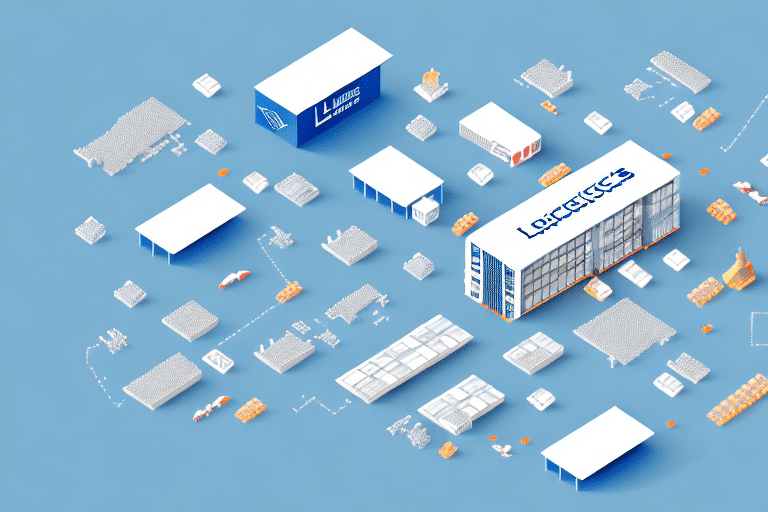Exploring the Benefits of Logistics Centers
Logistics centers, also known as distribution centers, are strategic locations where goods are stored, processed, and distributed to different destinations. They play a crucial role in supply chain management, enhancing efficiency, reducing costs, and optimizing business processes. According to a Statista report, the global logistics market was valued at over $8 trillion in 2023, highlighting the significance of logistics centers in the industry. In this article, we will explore the various benefits of logistics centers and their impact on the supply chain industry.
The Role of Logistics Centers in Supply Chain Management
Logistics centers are an integral part of supply chain management, ensuring product availability and timely delivery. They act as a bridge between manufacturers, suppliers, and customers, thus enabling an effective supply chain flow. By centralizing product storage, logistics centers reduce the need for multiple smaller warehouses, consolidating inventory and simplifying the logistics management process. This consolidation leads to increased efficiency and cost-effectiveness.
In addition to inventory management, logistics centers ensure product quality and safety. They provide controlled environments for storing and handling products, which is especially important for perishable goods and those with specific storage requirements. Strict quality control measures are in place to ensure that products are stored and transported in compliance with industry standards and regulations. This minimizes risks of product damage, spoilage, or contamination, safeguarding both businesses and consumers.
How Logistics Centers Improve Inventory Management
Logistics centers enable businesses to maintain optimal inventory levels strategically placed to ensure rapid response times. Positioned closer to target markets, these centers allow businesses to minimize delivery times and stay ahead of competitors. By consolidating inventory in one location, logistics centers facilitate easier management of stock movements, accurate tracking of stock levels, and prevention of overstocks or stockouts. This results in significant cost savings, as businesses can better control inventory levels and reduce wastage.
Furthermore, logistics centers offer value-added services such as packaging, labeling, and assembly, helping businesses streamline their supply chain processes. They also provide cross-docking services, allowing goods to be transferred directly from inbound to outbound trucks, reducing handling and storage costs. Real-time visibility into inventory levels and shipment statuses empowers businesses to make informed decisions and respond swiftly to changing market conditions.
Cost Savings through Supply Chain Optimization with Logistics Centers
Logistics centers optimize the supply chain by reducing transportation costs through minimized distances between suppliers and end-users. This optimization allows businesses to decrease the number of shipments, thereby lowering handling fees, inventory holding costs, and improving fulfillment rates. Companies leveraging logistics centers for supply chain optimization benefit from both cost savings and increased operational efficiency.
Centralized inventory management further enhances cost savings by enabling better tracking of inventory levels and reducing the risk of stockouts or overstocking. Advanced technology and equipment within logistics centers improve handling and storage efficiency, contributing to lower operational costs.
Additionally, value-added services such as packaging, labeling, and assembly streamline operations, reducing the need for multiple suppliers or vendors. Consolidating these services within a logistics center saves time and money while enhancing product quality.
The Advantages of Consolidating Warehousing and Distribution in a Logistics Center
Consolidating warehousing and distribution activities within a logistics center reduces operational complexity and enhances supply chain efficiency. By housing various logistics activities under one roof, businesses can manage their supply chain requirements more effectively, leading to cost savings and improved operational efficiency. This consolidation also optimizes space utilization, allowing for smaller warehouse footprints and reduced overhead costs.
Effective inventory management is another advantage of consolidation. With all inventory centralized, businesses can easily track and monitor stock levels, reducing the likelihood of stockouts or overstocking. This centralization leads to improved customer satisfaction, as businesses can better meet customer demand and fulfill orders promptly. Moreover, logistics centers often provide additional value-added services such as kitting, which further streamlines the supply chain and enhances operational efficiency.
The Impact of E-commerce on the Growth of Logistics Centers
The exponential growth of e-commerce has significantly increased the demand for logistics centers. With online shopping on the rise, businesses must deliver goods more quickly and efficiently to meet customer expectations. Logistics centers facilitate the storage of inventory closer to local markets, enable faster delivery times, and manage large order volumes effectively. According to a McKinsey report, the e-commerce sector is expected to grow by over 20% annually, underscoring the critical role of logistics centers in supporting this expansion.
Moreover, the growth of e-commerce has driven the adoption of new technologies and innovations within logistics centers. Automated sorting systems and robotics are increasingly implemented to enhance efficiency and reduce human error. The use of data analytics and artificial intelligence allows logistics centers to optimize operations and improve delivery times. As e-commerce continues to evolve, logistics centers must adapt and innovate to meet the escalating demand for faster and more efficient delivery services.
How Logistics Centers Enhance Efficiency in Transportation and Delivery
Logistics centers streamline transportation and delivery processes, significantly reducing the time required to process and transport goods. They enable the use of integrated transport solutions, simplifying logistics management and minimizing delivery costs. State-of-the-art logistics equipment and technology help businesses reduce handling time and minimize manual labor, thereby enhancing overall supply chain efficiency.
Centralized inventory management allows businesses to accurately track stock levels and ensure timely replenishment, preventing stockouts and delivery delays that can adversely affect customer satisfaction and business revenue.
Additionally, logistics centers offer value-added services such as packaging, labeling, and quality control, further streamlining the supply chain. By outsourcing these tasks to logistics centers, businesses can focus on their core competencies, improving overall productivity and profitability.
The Benefits of Integrating Technology into Logistics Operations
Integrating technology into logistics operations allows logistics centers to automate various processes, reducing errors and minimizing costs. Advanced tracking, monitoring, and communication tools enhance product visibility and traceability throughout the supply chain, fostering supply chain transparency, improving efficiency, and reducing operational costs. Technologies such as artificial intelligence and machine learning ensure accurate record-keeping, regulatory compliance, and precise order fulfillment, thereby enhancing customer satisfaction.
Furthermore, technology integration enables businesses to analyze data and gain insights into their supply chain performance. This analysis helps identify areas for improvement, optimize routes, and reduce delivery times. Real-time inventory monitoring allows businesses to manage stock levels effectively, avoiding stockouts and reducing inventory holding costs, which in turn improves cash flow. Overall, technology integration is essential for businesses to remain competitive in today's fast-paced and dynamic market.
Streamlining Operations with Automated Systems in Logistics Centers
Automated systems are pivotal in handling warehousing and distribution activities within logistics centers, reducing manual labor and minimizing errors. These systems streamline operations by increasing accuracy and speed, ensuring timely order fulfillment. Automation optimizes supply chain activities, reduces response times, and enhances the overall customer experience.
For instance, automated guided vehicles (AGVs) and warehouse management systems (WMS) facilitate efficient material handling and inventory tracking. By automating repetitive tasks, logistics centers can achieve higher productivity levels and lower operational costs, providing businesses with a competitive edge in the market.
Improving Sustainability in the Supply Chain through Logistics Centers
Logistics centers contribute to sustainable supply chain management by reducing the number of facilities required for storage and transportation, thereby minimizing energy consumption and carbon emissions. Effective logistics management decreases the distance between suppliers and customers, cutting down transportation-related emissions. According to the Environmental Protection Agency, logistics centers play a crucial role in reducing the environmental impact of supply chains.
Additionally, logistics centers implement efficient waste management practices, minimizing environmental impact and maximizing resource utilization. Sustainable practices such as energy-efficient lighting, solar power integration, and recycling programs are increasingly adopted in logistics centers to promote environmental responsibility.
The Future of Logistics Centers: Trends and Innovations
The logistics industry is rapidly evolving, with numerous trends and innovations shaping the future of logistics centers. The adoption of artificial intelligence and machine learning is revolutionizing logistics operations, enabling predictive analytics and enhanced decision-making. Blockchain technology is being utilized to improve transparency and traceability within the supply chain, ensuring the integrity of transactions and reducing fraud.
Other technological advancements, such as autonomous vehicles and drones, offer opportunities to further optimize transportation and eliminate inefficiencies. Robotics and automated storage systems enhance operational efficiency, while the Internet of Things (IoT) facilitates real-time monitoring and management of logistics activities. As logistics centers become more automated and integrated with advanced technologies, supply chain management will become more efficient, cost-effective, and responsive to customer needs.
Creating Competitive Advantage through Strategic Location of Logistics Centers
The strategic location of logistics centers is essential for gaining a competitive advantage in the market. Selecting locations that align with target market needs influences supply chain efficiency, minimizes transportation costs, and maximizes delivery times. Proximity to major transportation hubs, such as ports, airports, and highways, ensures seamless connectivity and facilitates rapid distribution of goods.
With the rise of e-commerce, strategically positioning logistics centers near urban areas allows businesses to offer faster delivery services and manage large order volumes effectively. This strategic placement not only enhances customer satisfaction but also reduces last-mile delivery challenges, providing businesses with a significant edge over competitors.
Enhancing Customer Experience with Efficient Order Fulfillment from Logistics Centers
Efficient order fulfillment through logistics centers plays a crucial role in enhancing the customer experience. By minimizing delivery times and reducing errors, logistics centers ensure that customers receive their orders promptly and accurately. This reliability in delivery fosters customer satisfaction and loyalty, which are critical for business growth.
Moreover, logistics centers enhance product visibility by providing real-time tracking information, allowing customers to monitor their orders throughout the delivery process. This transparency builds trust and improves the overall shopping experience. By offering a fast, seamless, and cost-effective delivery service, businesses can differentiate themselves from competitors and strengthen their market position.
Mitigating Supply Chain Risks with Robust Contingency Plans in Logistics Centers
Logistics centers play a vital role in mitigating supply chain risks by implementing robust contingency plans. These plans enable businesses to respond effectively to unforeseen events such as natural disasters, supply chain disruptions, or unexpected spikes in demand. For example, having multiple distribution channels within a logistics center ensures product availability even during crises, minimizing the impact of disruptions on business operations.
Robust contingency plans enhance supply chain resilience, allowing businesses to maintain continuity and efficiency under challenging circumstances. By proactively addressing potential risks, logistics centers help in safeguarding business operations and ensuring sustained performance.
Case Study: Successful Implementation of a Logistics Center for Increased Business Performance
A notable example of successful logistics center implementation is Amazon's fulfillment centers. These centers are strategically located across various regions, enabling Amazon to offer rapid delivery services such as same-day and next-day shipping. By consolidating warehousing and distribution activities, Amazon reduces intermediary storage costs and enhances supply chain visibility. The implementation of advanced automation technologies in these centers has resulted in significant cost savings, improved inventory management, and increased product availability, thereby boosting Amazon’s business performance and customer satisfaction.
This case study demonstrates how effective logistics center management can lead to enhanced operational efficiency, cost reductions, and improved business outcomes.
In conclusion, logistics centers are indispensable for businesses aiming to optimize supply chain management. The benefits, including efficient transportation, advanced inventory management, cost savings, sustainable operations, and more, are clear. Logistics centers provide businesses with a competitive advantage, enabling faster and more cost-effective delivery services, enhancing customer satisfaction, and improving overall business performance.




















